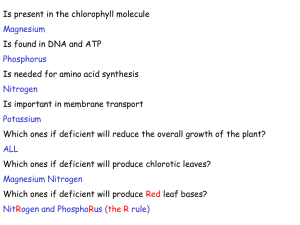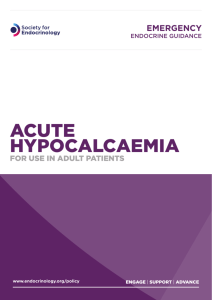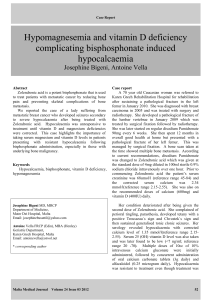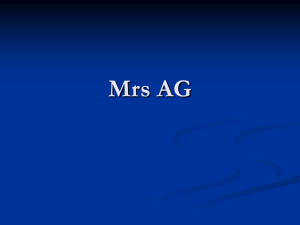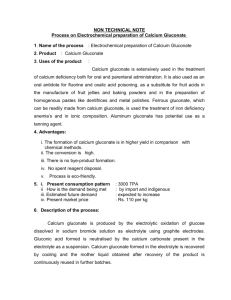012 - Practical Points on Hypocalcaemia
advertisement
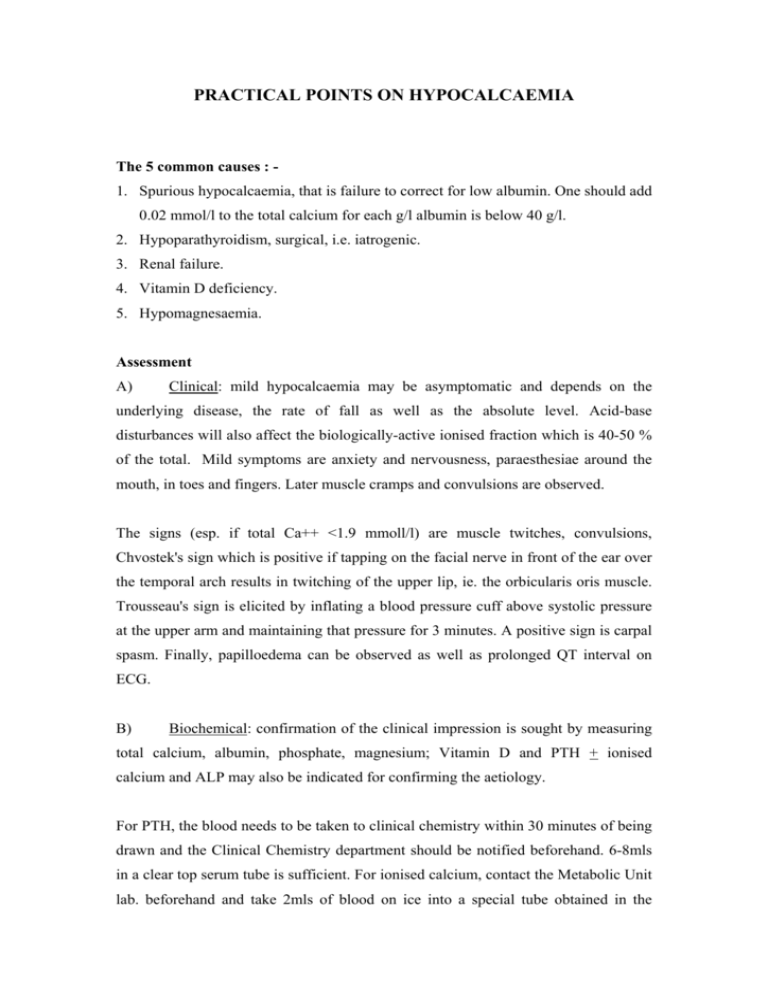
PRACTICAL POINTS ON HYPOCALCAEMIA The 5 common causes : 1. Spurious hypocalcaemia, that is failure to correct for low albumin. One should add 0.02 mmol/l to the total calcium for each g/l albumin is below 40 g/l. 2. Hypoparathyroidism, surgical, i.e. iatrogenic. 3. Renal failure. 4. Vitamin D deficiency. 5. Hypomagnesaemia. Assessment A) Clinical: mild hypocalcaemia may be asymptomatic and depends on the underlying disease, the rate of fall as well as the absolute level. Acid-base disturbances will also affect the biologically-active ionised fraction which is 40-50 % of the total. Mild symptoms are anxiety and nervousness, paraesthesiae around the mouth, in toes and fingers. Later muscle cramps and convulsions are observed. The signs (esp. if total Ca++ <1.9 mmoll/l) are muscle twitches, convulsions, Chvostek's sign which is positive if tapping on the facial nerve in front of the ear over the temporal arch results in twitching of the upper lip, ie. the orbicularis oris muscle. Trousseau's sign is elicited by inflating a blood pressure cuff above systolic pressure at the upper arm and maintaining that pressure for 3 minutes. A positive sign is carpal spasm. Finally, papilloedema can be observed as well as prolonged QT interval on ECG. B) Biochemical: confirmation of the clinical impression is sought by measuring total calcium, albumin, phosphate, magnesium; Vitamin D and PTH + ionised calcium and ALP may also be indicated for confirming the aetiology. For PTH, the blood needs to be taken to clinical chemistry within 30 minutes of being drawn and the Clinical Chemistry department should be notified beforehand. 6-8mls in a clear top serum tube is sufficient. For ionised calcium, contact the Metabolic Unit lab. beforehand and take 2mls of blood on ice into a special tube obtained in the Metabolic Unit. It needs to be in the Metabolic Unit within 30 minutes of being drawn. C) Typical Biochemical Pattern: PTH 25(OH)D l,25(OH)D Ca~ PO4 Mg++ ALP * Hypoparathyroidism Surgical Low Low/Normal Low Low High Normal Normal* Renal Failure Vit D Deficiency (Nutr./Malabs.) High High Normal Low Low Low/Normal Low Low High Low/normal Normal Normal High High Hypomagnesaemia Low/Normal Normal Low Low Normal/high Low Normal Remember the now rare Hungry Bone Syndrome Treatment of Hypocalcaemia in Hospital • If the cause is hypomagnesaemia, for example in chronic alcoholism, malabsorption, cyclosporine treatment, prolonged parenteral nutrition or diuretic therapy, treatment is with iv magnesium. For acutely symptomatic patients with convulsions, 8 mmols magnesium sulphate are diluted in 100 ml normal saline and infused over 20 minutes. The total deficit is usually 0.5 - 1 mmol/kg which should then be replaced over 4 - 5 days intravenously. In mildly symptomatic or asymptomatic patients with chronic hypomagnesaemia, oral replacement can be tried (24 mmol/d as magnesium glycerophosphate) which is often difficult due to diarrhoea. • For hypocalcaemia, oral or iv calcium + vitamin D will be required. Therapeutic end point is low normal calcium. In asymptomatic, chronic hypocalcaemia, 3 - 7 g of calcium daily PO in multiple, divided doses can be effective. Often, vitamin D will be needed as well. It is preferable to use shorter-acting vitamin D analogues as that will make it easier to reverse any toxicity/hypercalcaemia. See table below. • For emergency treatment of hypocalcaemia, 20mls of calcium gluconate 10% iv over 15 minutes will reverse tetany. Then, slow iv infusion at 0.5 - 2 mg/kg/h as calcium gluconate 10% 60 - 80 ml diluted in 1 litre 5% dextrose. (10% calcium 2 gluconate cont. 8.9 mg elemental Ca++/ml). Oral therapy as above + vitamin D should then be introduced as soon as possible. Trade Name Potency Vit D3/D2 Calciferol (Cholecalciferol/ ergocalciferol) One Alpha 1-hydroxy cholecalciferol (Alfacalcidol) Calcijex 1,25-dihydroxy Rocaltrol cholecalciferol (Calcitriol) Onset of Action Duration of Action Initial Dose Usual Maintenance Dose 10 µg 1 10-14 d weeks - months 1000 1-2 d 2-3 d 2 µg 0.25-1 µg 1000 1-2 d 2-3 d 2 µg 0.5-1 µg Protocol prepared by Rafn Benediktsson, 1996 Revised October, 2002 3


